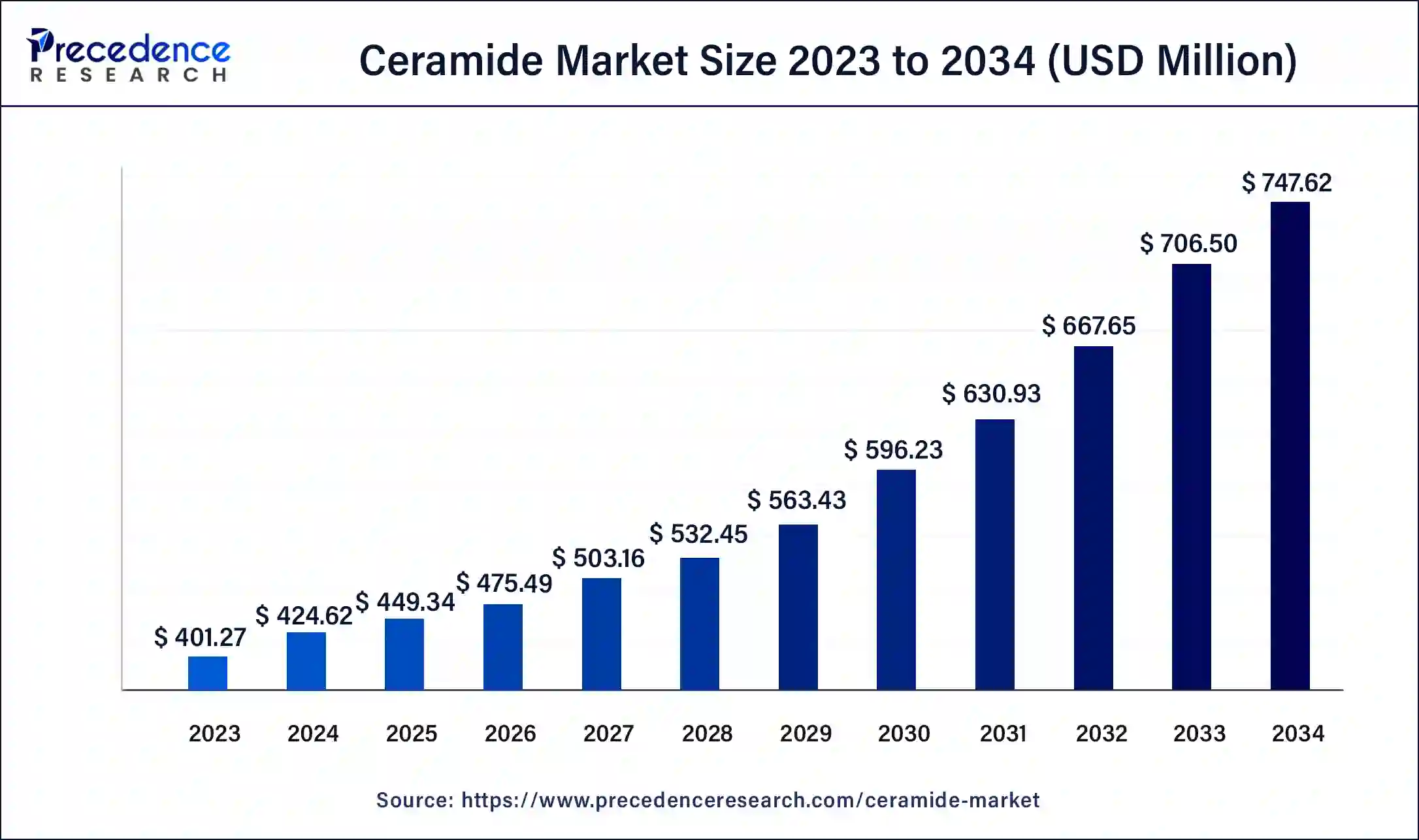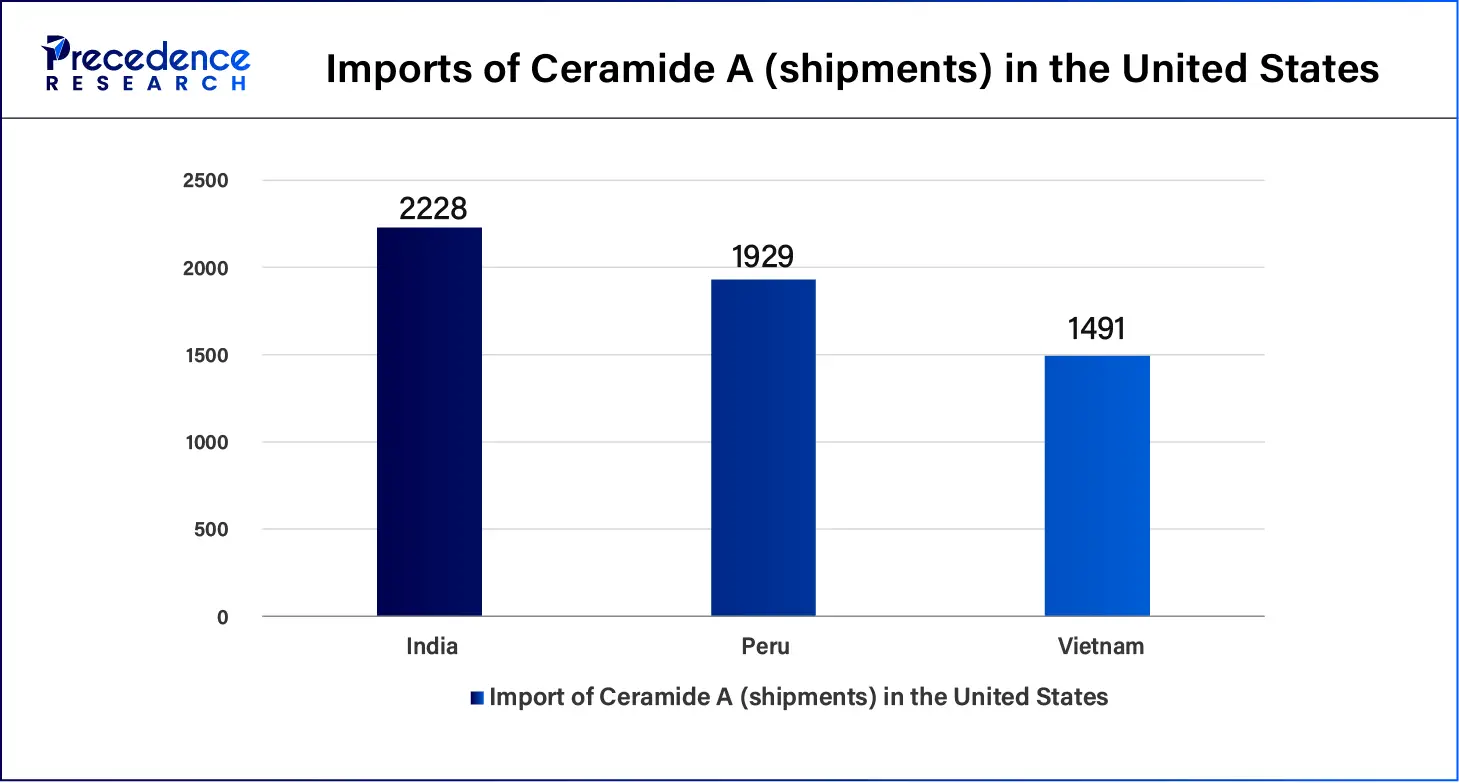The global ceramide market size surpassed USD 401.27 million in 2023 and is estimated to increase from USD 424.62 million in 2024 to approximately USD 747.62 million by 2034. It is projected to grow at a CAGR of 5.82% from 2024 to 2034.
The global ceramide market size is worth around USD 424.62 million in 2024 and is anticipated to reach around USD 747.62 million by 2034, growing at a solid CAGR of 5.82% over the forecast period 2024 to 2034. The increased use of ceramides in the nutraceutical industrial sector, pharmaceutical industrial sector, and cosmetics industrial sector and growing ceramide-based antiaging skincare products contribute to the growth of the market.

The ceramide market refers to buying and selling ceramides, which are a family of waxy lipid molecules. These are composed of sphingosine and a fatty acid joined by an amide bond. The benefits of ceramides include protecting our skin from infection-causing germs like fungi and bacteria and allergies. It helps to protect our skin from environmental damage, prevent irritation and dryness by locking moisture into the skin, protect our skin from breakouts, reduce the appearance of wrinkles, help the skin to maintain an ideal amount of moisture, and protect the skin’s natural barrier.
How can AI help the Ceramide Market?
The use of artificial intelligence (AI) in the ceramide can improve the growth of the ceramide market. The benefits of AI include improved cyber security, improved agriculture, improved financial services, scientific discovery, customer service excellence, advanced transportation, climate change mitigation, increased economic growth, and improved healthcare. Artificial intelligence gives humans the ability to achieve a high range of goals and solve problems. In the cosmetic industry, AI can help in product creation. AI can used as an analytical tool for creating personalized shopping experiences and inventory management. It is used as an additional channel for sales, communication, and promotion.
| Report Coverage | Details |
| Market Size by 2034 | USD 747.62 Million |
| Market Size in 2024 | USD 424.62 Million |
| Market Growth Rate from 2024 to 2034 | CAGR of 5.82% |
| Largest Market | Asia Pacific |
| Base Year | 2023 |
| Forecast Period | 2024 to 2034 |
| Segments Covered | Type, Process, and Regions |
| Regions Covered | North America, Europe, Asia-Pacific, Latin America and Middle East & Africa |
The growing cosmetic industry
Ceramides are highly used in cosmetic products like skin care products, including eye creams, serums, face oil, face masks, and face creams. Ceramides are essential lipids that are naturally found in our body, help hold hydration in the skin, and maintain the integrity of the skin barrier. So, ceramide-based products are used in skin care products, which help to keep skin looking firm, plump, and healthy by reducing the appearance of fine lines, which helps the growth of the ceramide market. The benefits of ceramide include infection-causing germs like fungi and bacteria and allergies. It protects your skin from environmental damage and prevents irritation and dryness by locking moisture into your skin. It protects our skin from breakouts and drying out, reduces the appearance of wrinkles, helps the skin maintain an ideal amount of moisture, etc.
Regulatory compliance
The regulatory compliance challenges include inefficient task management, cyber security, and data privacy risks, the convergence of finance and technology, managing third-party technologies, addressing new policies and guidelines, a burden on compliance teams due to rapidly evolving regulations, etc. Regulatory risks may cause human error, negligence, and inadequate controls. These factors can hamper the growth of the ceramide market.
Increasing use in the pharmaceutical industry and changing consumer preferences
In the pharmaceutical industry, ceramides are used in drug delivery, which helps the ceramide market grow. It belongs to the sphingolipid group of lipids that acts as intercellular and intracellular messengers and as regulatory molecules that play important roles in signal transduction, metabolic, inflammation, and angiogenesis disorders like cancer cell degradation, diabetes, and neurodegenerative diseases. Effective supply chain management, including customer satisfaction, distribution, logistics, production, and sourcing, leads to the growth of the market.
The natural ceramides segment dominated the ceramide market in 2023. The natural ceramide sources include whole grains like quinoa, wheat, corn, brown rice etc., olives, spinach, sesame seeds, broccoli, eggs, almonds, whole grains, sweet potatoes, wild-caught salmon, soybeans, avocadoes, etc. Olives and olive oil have ceramide-rich compositions that have skin-boosting properties that help improve skin hydration and elasticity. Spinach contains vitamins, minerals, and ceramides, and its iron content helps to support skin cell regeneration and improve blood circulation and overall skin health. Sesame seeds have important minerals like zinc and copper and are a rich source of ceramides, which can help reduce inflammation, enhance skin elasticity, and improve skin health. Broccoli is a cruciferous vegetable that has nutrients and ceramides that help to reduce toxins from the body and support digestion, helping to improve skin radiance and clarity. Eggs are a rich source of ceramides that help maintain and repair skin cells and help create a radiant and healthy complexion.
The synthetic ceramides segment is expected to grow significantly during the forecast period. Synthetic ceramides are lab-derived. Natural and synthetic ceramides are both effective and safe to use. Synthetic ceramides are also called pseudoceramides, which are man-made. These are more stable than natural ceramides because they are free from contaminants. The use of topical ceramides can be effective at increasing water retention and restoring barrier function, and, in patients with atopic dermatitis, helps to enhance the skin barrier.
The fermentation ceramides segment dominated the ceramide market in 2023. In some of the companies, ceramides are obtained from the fermentation method. The Evonik company has developed fermentation or green production technology for producing ceramides that can be converted into human skin-identical molecules for cosmetics. The fermentation method can create molecules like hyaluronic acid, peptides, and lactic acid, which can improve the production of ceramides that help retain skin moisture and form the skin’s barrier. It also helps to stimulate the skin’s natural antimicrobial peptide production, which regulates acne-causing bacterial and pathogenic levels.
The plant extract ceramides segment is anticipated to be the fastest-growing during the forecast period. Natural ceramide is a biologically active compound present in plants that is used highly in the cosmetics, pharmaceutical, and cosmetic industries. The ceramide contents in plants can be obtained by a ceramide extract analysis, which is helpful for the development of ceramide sources. The plants that are rich in ceramides, including spinach, sesame seeds, broccoli, almonds, whole grains like quinoa and brown rice, sweet potatoes, soybeans, avocadoes, etc., contribute to the growth of the ceramide market.
Asia Pacific held the largest share of the ceramide market in 2023. In the Asia Pacific region, there is a high consumption rate of wheat, soybeans, and rice products through many cosmetic products and food supplements. China has the highest rice consumption compared to India. Japan is the leading country for the growth of the ceramide market in the Asia Pacific region. Additionally, China and India have significant demand for soybean oil and wheat products, which are important natural sources of ceramides. The high number of consumers spending on cosmetics and personal care products.
North America is observed to be the fastest growing in the upcoming years. In North America, consumers find solutions to reduce the appearance of wrinkles and fine lines, which leads to increased demand for ceramides. Ceramides are popular anti-aging products in this region, which helps to the growth of the market. The senior population contributes to the demand for ceramides. Consumers' awareness of maintaining skin hydration and health increased the demand for ceramides for beauty products and skincare products. Increased use of ceramides as food additives and functional foods.
According to Volza’s United States Import Data
The United States imports most of the Ceramide A from China.
Globally, the top three importers of Ceramide A are Vietnam, India, and Peru. India leads the world in Ceramide A imports with 2228 shipments, Peru with 1929 shipments, and Vietnam with 1491 shipments.

Segments Covered in the Report
By Type
By Process
By Geography
For inquiries regarding discounts, bulk purchases, or customization requests, please contact us at sales@precedenceresearch.com
No cookie-cutter, only authentic analysis – take the 1st step to become a Precedence Research client